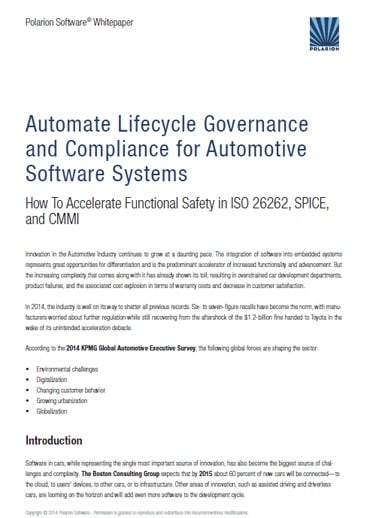Accelerate Automotive Innovation to Top Speed (Part 3 of 6)
Innovation has become an exercise of advancing embedded systems to stay ahead in the highly competitive automotive industry. While opening up great new opportunities, integration of software into mechatronics also presents unprecedented challenges to development teams.
This series of articles presents an in-depth look at the challenges facing the rapid advance of mechatronics in the automotive industry, and discusses business best practices gleaned from our customers successfully using Polarion solutions to meet the challenges. Part 1 was an overview of the challenges. Part 2 looked at effective real-time collaboration strategies. In this third article, we’ll continue the discussion of strategies for mastering them.
Proactive Protection of Quality and Functional Safety
Of course, real-time collaboration and seamless integration of tools per se doesn’t protect development teams from errors and defects. As the General Motors recall crisis and other similar debacles show, it’s clear that the entire auto industry’s approach to quality management has to change and become more proactive. The old ways of dealing with safety flaws, which essentially boiled down to issuing recalls and compensating victims privately through nondisclosure agreements, no longer suffice. Regulators won’t put up with them, and the public won’t accept them either. To make matters worse, emerging details of stalling, incompetence and lax behavior at GM leaves everybody else without a plausible defense going forward. The industry is pivoting as a result. For starters, the economics of auto safety are fundamentally reversing, making the cost of repairs far more expensive than prevention.
Troubleshooting issues along the automotive development continuum can be a very time consuming task, especially when traceability is not readily available in the software development process for each individual component. To this day, this can still be a cause for car manufacturers and their suppliers to either delay a release, or ship a car with a plan in place to issue very costly recalls once the defects surface. Determining release readiness across the isolated groups and systems in today’s global automotive development ecosystem is time consuming and error prone. Also, the risks of making key decisions increase in direct proportion with the complexity, incompleteness and inaccuracy of data on which they are based.
This has led to the rise of ISO 26262, an adaptation of the Functional Safety standard IEC 61508 for Automotive Electric/ Electronic Systems, which defines functional safety for automotive equipment applicable throughout the lifecycle of all automotive electronic and electrical safety-related systems. VDC Research reports that adherence to ISO 26262 is expected to increase significantly in the next two years, making it imperative to understand the various safety processes as well as legal responsibilities required to achieve compliance.
 Polarion is the first ALM vendor to receive ISO 26262 / IEC 61508 qualification by TÜV NORD for its suite of products. The qualification at the highest Automotive Safety Integrity Level (ASIL-D) as defined in ISO 26262 is based on evidence that Polarion’s software development processes can be reliably implemented and replicated. Due to the nature of the qualification, any software and hardware systems developed using Polarion’s processes is also deemed to meet the functional safety requirements of ISO 26262, in turn radically reducing compliance efforts.
Polarion is the first ALM vendor to receive ISO 26262 / IEC 61508 qualification by TÜV NORD for its suite of products. The qualification at the highest Automotive Safety Integrity Level (ASIL-D) as defined in ISO 26262 is based on evidence that Polarion’s software development processes can be reliably implemented and replicated. Due to the nature of the qualification, any software and hardware systems developed using Polarion’s processes is also deemed to meet the functional safety requirements of ISO 26262, in turn radically reducing compliance efforts.
Polarion’s customers have been able to take advantage of this qualification and its underlying functionality to quickly comply with the new standard. They are using out-of-box features including a custom work item type called “Risk,” as well as FMEA (Failure Mode and Effect Analysis) templates and pre-configured workflows that involve before and after Risk Priority Number (RPN) scoring based on user-defined values of Severity, Occurrence, and Detection. Additionally, Polarion has elevated risk analysis to a “first-class” citizen within the solution workflow.
This means that customers can easily achieve traceability starting from the granular risks identified in an FMEA, to mitigating requirements and subsystem designs, and from there outward to test cases that verify such requirements. From there, they can further trace those same risks through the results of the executed test cases, right to the source code used for implementing the corrective software components. Thanks to extensions such as the Polarion Connector for MATLAB® Simulink®, it’s even possible to achieve traceability all the way into model elements. This has allowed Polarion customers to become much more proactive in their risk assessment and functional safety practices, and much faster in being able to prove compliance.
Besides supporting the effective management of defects and risks, multi-directional traceability and change history tracking are essential for fast proof of compliance. Every artifact change in Polarion is tracked using the underlying configuration management system. The tool itself comes with Subversion, but can also be easily tied in with any of the other configuration applications such as GIT and Perforce.
The automated tracking functionality makes it impossible to change anything without leaving a trace, and helping to further reduce the risk of defects and functional safety complaints. It goes without saying that this proactive approach to ALM is a much more cost effective business practice. Our customers confirm that their development teams can bring high quality automotive products to market much faster when they can find and fix issues before they become a problem. In fact, correcting errors long before final verification leads to tremendous overall savings in development time and project costs, along with reducing the probability of expensive recalls, let alone legal action due to bodily harm.
Next time…
In Part 4 of this series, we’ll continue looking at strategies: Rapid Response to Defects after Market Introduction
“I’ve been working for over 20 years in automotive electronic development. With Polarion, it is the first time that the entire spectrum of development activities is covered by one tool. This allows closer collaboration between software, hardware, mechanical, project management, test and requirements management which improves the product quality, protects functional safety, and saves time and money.”
— Rainer Kirchner, ASK Industries
YOU MIGHT ALSO BE INTERESTED IN READING:
FREE WHITEPAPER:
Automate Lifecycle Governance and Compliance for Automotive Software Systems – How To Accelerate Functional Safety in ISO 26262, SPICE, and CMMI
[SFP]



